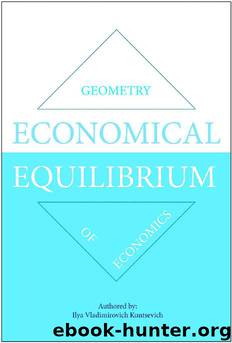Economical Equilibrium by Ilya Kuntsevich

Author:Ilya Kuntsevich [Kuntsevich, Ilya]
Language: eng
Format: epub
ISBN: 9781492387510
Publisher: Ilya Vladimirovich Kuntsevich
Published: 2013-09-19T04:00:00+00:00
PART II: GLOBAL ECONOMY
Economic Growth
The global value of economics and wealth increase as the standard of living increases, i.e. both contribution and demand increase at the expense of once abundant natural resources. Human labor and technology helps convert natural resources into devices, homes, cars, etc., which are valued by the society and associated with so called civilization, progress and overall standard of living. Recent technological advances allow more people to enjoy lifestyles they could only dream about 20–30 years ago. The monetary base and its velocity increase in order to support increased consumption, because more goods and services are exchanged.
In order for you to sell something, someone else has to have money to buy it. The economy grows organically as people invent new things and make technological progress, although it causes wealth inequality, as discussed in Part I. Nevertheless people tend to try new items and thus exchange these items if they find them of value.
In the past people used to trade and accumulate gold and silver as the only means of exchange. Today people trade to accumulate paper and electronic money, because everything can be exchanged for it, including gold and silver. Lending money in the form of debt became an option after profits started to accumulate on the banks’ balance sheets, because money would have been continuously circulated otherwise and banks would have no discretion over its use.
Spent debt (e.g. credit cards, HELOCs, student loans, etc.) has no immediate cash value, because a person who received debt money and spent it didn’t contribute anything that can be immediately monetized. On the other hand, this debt money, spent on goods and services, increases GDP. Therefore, real GDP growth (not debt financed) occurs only when there is an equivalent contribution by labor or technological conversion of natural resources.
How much money does an economic system need? As much as it takes to exchange goods and services multiple times during a given period. Excess money, accumulated from profits, stays within the financial system, waiting for allocation in order to grow the economy further. When economic growth stops or slows down, excess money sits idle, unless it is introduced to other economies in a form of debt, which then stimulates the local economy.
As a consequence of the 2008 crisis, money was printed post-2008 by the Federal Reserve in order to deleverage banks and bring liquidity into the financial system. Such policy will eventually cause CPI inflation that will be absorbed by all participants involved in the economic process, because there is still no real contribution justifying printing more money. The only measure that “saves” the U.S. from high CPI inflation today is the “export” of inflation in the form of international debt increase.
Profit recognition effectively reflects more work required in order to justify monetary inflation and economic growth. Part II covers this and other matters pertaining to the current state of the modern global economy.
Download
This site does not store any files on its server. We only index and link to content provided by other sites. Please contact the content providers to delete copyright contents if any and email us, we'll remove relevant links or contents immediately.
International Integration of the Brazilian Economy by Elias C. Grivoyannis(91938)
The Radium Girls by Kate Moore(11930)
Turbulence by E. J. Noyes(7942)
Nudge - Improving Decisions about Health, Wealth, and Happiness by Thaler Sunstein(7622)
The Black Swan by Nassim Nicholas Taleb(7016)
Rich Dad Poor Dad by Robert T. Kiyosaki(6414)
Pioneering Portfolio Management by David F. Swensen(6230)
Man-made Catastrophes and Risk Information Concealment by Dmitry Chernov & Didier Sornette(5926)
Zero to One by Peter Thiel(5692)
Secrecy World by Jake Bernstein(4652)
Millionaire: The Philanderer, Gambler, and Duelist Who Invented Modern Finance by Janet Gleeson(4386)
The Age of Surveillance Capitalism by Shoshana Zuboff(4216)
Skin in the Game by Nassim Nicholas Taleb(4165)
Bullshit Jobs by David Graeber(4101)
The Money Culture by Michael Lewis(4083)
Skin in the Game: Hidden Asymmetries in Daily Life by Nassim Nicholas Taleb(3935)
The Dhandho Investor by Mohnish Pabrai(3706)
The Wisdom of Finance by Mihir Desai(3659)
Blockchain Basics by Daniel Drescher(3511)
